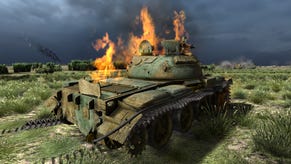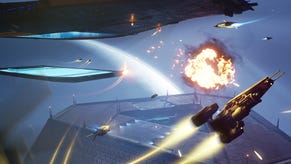The Flare Path: Missing Link
Simulation & wargame blather
Back in the mid 1920s there wasn't much point in going into a game retailer and asking to see their flight simulation selection. At best you'd be directed towards a display of dead pheasants, partridges and pigeons by a burly man with blood on his apron. At worst you'd be branded a "timewaster" and a "loon" by a burly man with blood on his apron, before being unceremoniously ejected from the shop. Until Edwin Albert Link's electro-pneumatic pilot trainer arrived in 1929, flight simulation involved outstretched arms and enthusiastic droning; it was what children did on seeing the biplanes of touring barnstormers overhead.
An avid aviator and experienced pianola engineer, the visionary Mr. Link realised that the same technology that breathed life into the organs and player pianos manufactured in his father's factory, could be used to create a device that would cut the costs and risks associated with pilot training. Utilizing a complicated system of bellows, pumps, tubes and belts, his original simulator was eighteen months in the making and took the form of a miniature stub-winged monoplane mounted on a mechanism-concealing pedestal. Once aboard, flightstick wagglers got to experience first-hand the unique challenges of controlling a craft that pitched and rolled (yaw came later) at the slightest provocation.
The world of aviation was slow to appreciate this faux flying machine. During the the early Thirties, unless you were a US amusement park visitor or a student at Link's own New York flying school, you were unlikely to encounter one. It took a political scandal and a rash of pilot deaths to change mindsets. In February 1934 the US Army Air Corps was given responsibility for delivering airmail. Unprepared and ill-equipped for the task, they lost ten fliers in accidents within a fortnight of commencing operations. Blizzards combined with poor instrument flying ability were at the root of most of the prangs. Could Link's 'blue box', now upgraded with rudder pedals and full instrumentation, help bridge the skills gap? After military officials saw for themselves an example of simulator-derived proficiency (Link flew through thick fog to attend one crucial meeting with Army officers) six trainers were purchased at $3500 a piece; the seeds of an eighty-year relationship and a multi-billion pound industry were sown.
It's impossible to estimate how many lives the most common Link model, the ANT-18, has helped save over the years. During WW2 more than ten thousand of these devices emerged from workshops in the US, Canada, and the UK. Most Allied aviators that fought in Western Europe, the Pacific, North Africa and the Far East would have experienced the palm-moistening pressure of a blind-flying exercise at some point during their service.
Sitting under the simulator's opaque canopy, scrutinising gauges and gingerly manipulating yoke and pedals, the incarcerated must have been acutely aware that every mistake and miscalculation was being recorded by 'the crab', an automatic position plotter that scrawled a telltale flightpath track on a map overlay at a connected station. Fliers that ended up miles from an intended destination would have faced searching questions from their instructor/assessor. Repeated failures on the ANT-18 during the early stages of an airforce career would almost certainly have put pilot wings out of reach.
I was reflecting on this as I clambered into the cockpit of a 1952 ANT-18 at a local aviation museum earlier this week. The machine in question was fitted with a clear canopy and the map table/instructor's station was U/S, but there was still something slightly intimidating about its busy panel, mechanical bull stance and faint scent of lubricating oil and vacuum tubes. I'd been warned by my guide (a retired Phantom pilot) to expect a little control lag, but as the ANT-18 whirred into life (Cold start procedure: Flick one of the two magneto switches and lower a locking lever) what struck me first was the unexpected sensitivity of the controls. During my first minute or two 'aloft', the little blue mount lurched about like a lilo on a heavy swell. Very soon I found myself adopting a technique I sometimes resort to when flying challenging PC sims; I uncurled my fists from the yoke and relied on thumb and fingertips to suggest rather than decree direction changes.
Delicate digits eventually did the trick. The artificial horizon ceased its drunken wallowing and I felt ready to attempt a few gentle turns...
Here we go. A tentative tilt of the yoke. A complimentary soupçon of rudder and... CRIKEY! WOAH THERE! A glimpse of curved hangar roof is swiftly followed by a glimpse of sea-grey hangar floor. My guide who is perched on the Trainer steps like a reluctant paratrooper, hangs on like grim death while I struggle to get the Link level again. I start to wish I hadn't mentioned my "years of simulator experience".
Under its fairground ride exterior, the ANT-18 hides some remarkably sophisticated features. As well as the sets of bellows that simulate pitch, roll and yaw movements, there's a motor that can mimic turbulence. As I had a passenger riding shotgun while I flew, I didn't have the opportunity to test the pre-stall buffet simulation or - gulp - the synthetic spins (Probably a good thing; a rather pretty Meteor U.16 was well within projectile vomit range) but before 'landing' I did play with the extensive radio apparatus on the right side of the pit and experiment with the three fully functioning trim wheels nestling against my left thigh. Simply sitting a few inches from a panel studded with beautiful analogue gauges was a joy. That impulse that drives some simmers to spend long years and small fortunes fabricating cockpit-shaped play spaces filled with period-appropriate controls and instruments - I'm beginning to understand it.
A surprising number of Link Trainers have survived the cutter's torch. Diminutive, utilitarian, and faintly comical, they are easy things to overlook in museums full of WW2 icons and sleek jets. However, hurry past on your way to pat that P-51 or leer at that Lancaster and you'll slight a true aviation landmark - the great-great-grandpappy of the PC sims we pilot and prize today.
**************************************
"Crank the enemy up to elite, increase jungle density, use political defeat and then drop me a line and tell me how it went....."
Johan Nagel's (the developer of Vietnam '65) advice to anyone who's still finding this refreshingly unconventional logistics-heavy COIN game too easy. Updated this week, V65 now features Phantom-grounding rainstorms, visible FoW, toggleable hexgrids, nameable units and villages, and numerous new skirmish customisation options (Full change list here). Though the older I get, the more I resent having to painstakingly handcraft my own wargame difficulty settings (nothing underlines artifice like commencing a battle with the question "How do you like your scraps?") I'll definitely be returning for a second tour now resistance has been stiffened.
What's next now the patch is in country? Well, going by the following forum message, the V65 engine will shortly be taking on the Taliban.
**************************************
I was hoping to bring you some Scourge of War: Waterloo impressions today, but, though there's less than a week to go before release, it appears NorbSoftDev and Matrix/Slitherine are still polishing buttons, ironing kilts, and painting "If found, please return to..." messages on cannonballs. Is SoW: Waterloo merely a camouflaged SoW: Gettysburg? Can NSD's revised AI think like a Napoleonic tactician? Scour the following overview vids for clues.
**************************************
The Flare Path Foxer
Like Leicestershire's fabled Lost City of Pewter, last week's foxer theme remains undiscovered. Roman is convinced that some clever collage-educated reader will eventually spot a connection between the Bowers Fly Baby, the K9 self-propelled howitzer, the WW1 memorial plaque, the pulp mag, the Fairey Delta 1, the Class 53, Dandelion the bard, Harry Palmer and the ****** ******** hence the pair of puzzles pasted below.
All answers in one thread, please.


























